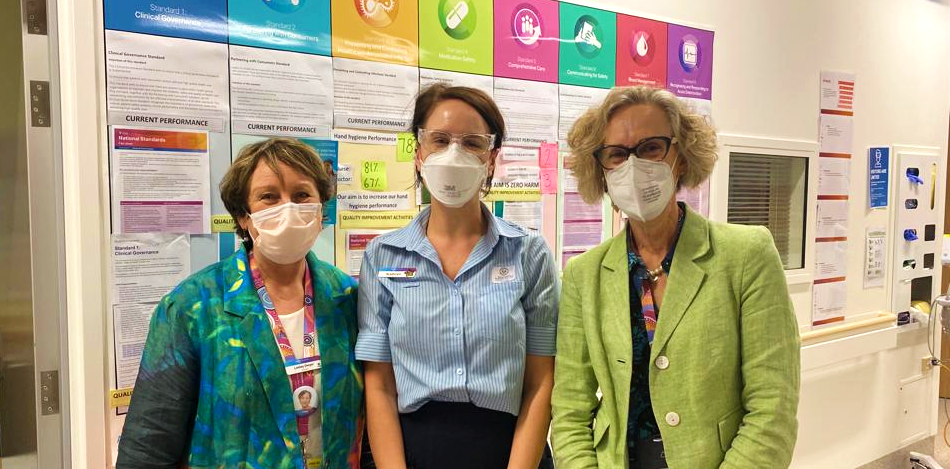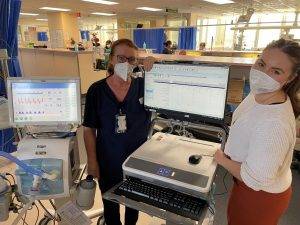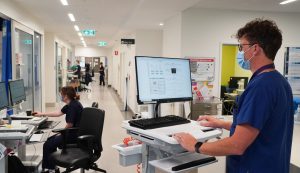Two hospitals within the Central Adelaide LHN (CALHN) have become the first public hospitals in Australia to implement a real-time data monitoring system which provides advanced warning to medical staff of patient deterioration.
The Ainsoff system monitors a host of patient variables and pathology results to anticipate deteriorations in patient status, automatically alerting medical staff and allowing them to intervene sooner.
Following a successful silent trial, a live trial is now underway at the Royal Adelaide Hospital and the Queen Elizabeth Hospital.
Widespread praise
Professor Jane Andrews, Medical Stream Lead (Surgery 3), has championed the integration of Ainsoff from the start.
“The system uses excellent logic from a clinical perspective and expedites our ability to make decisions that benefit patient care,’ she said.
“This will become part of our normal safety standards and give us an uplift in bringing care forward.”
In providing another safety net for staff and patients, Ainsoff has been accepted across all roles within clinical staff.
“What I hadn’t anticipated is the absolute acceptance by staff. Nursing staff acceptance has been outstanding,” said Professor Andrews.
“The consultants who have patients in the wards have all endorsed the process and are very happy to hear that we have started the live trial.”
Early reports from staff show the system is already providing benefits. By supplying clear and immediate information on patient deterioration, it empowers nursing staff to lead the decision-making process with the clinical team.
In an early example, Ainsoff alerted nursing staff to the potential of sepsis in one patient, which empowered a junior nurse to raise the alarm to the medial staff and initiate an early intervention.
Kathryn Mazeika, a Nurse Unit Manager, has embraced the new technology.
“It’s a lot easier to visually see the information there at hand and it’s a very good prompt to go and physically view the patient,” she said.
“I can’t see anything but positives. I really like it.”
Early signs of success
A successful two-week ‘silent’ trial of Ainsoff highlighted potential areas of significant benefit.
Ainsoff incorporated five years of historical data and monitored more than 2000 patients in the background, registering silent alerts without interfering in the normal functioning of nursing and medical staff.
Ainsoff proved to be highly sensitive. It successfully predicted 19 out of 23 patients who needed to move to the intensive care unit. It also predicted 73 per cent of medical emergency team calls more than one day advance.
The alerts would not have created a large addition to the workload of clinicians, with most alerts representing a deterioration of a patient that required action by the medical staff.
Upon implementation, this would allow staff to bring treatment forward in time, before the deterioration escalates. It would also predict the need for ICU beds in advance.
Going forward
The success of the silent trial has encouraged the launch of a live three-month trial in the same four wards and will notify nursing shift coordinators with important alerts by text message.
After six weeks, staff will begin analysing the effect, starting by examining the number of daily alerts generated per ward. Further analyses focus on the rates of medical emergency team calls, medical emergency response calls and unplanned ICU admissions, comparing to pre-trial rates and the rates within similar wards currently operating without Ainsoff.
Finally, nursing and medical stuff will also provide their feedback on the user experience.
If the system is proven to be successful, Ainsoff could then be rolled out across CALHN. The following step would then be full integration within the Electronic Medical Record system, which would also benefit the other local health networks.
A gamechanger – how it works
Providing world-class care, enabled by excellent technology, is at the heart of CALHN’s strategic ambitions.
Experienced medical doctors and computer scientists developed the state-of-the-art Ainsoff system which monitors patients the way a senior clinician would.
The current Electronic Medical Record system alerts medical staff if there is an issue with a given observation based on set criteria.
Ainsoff, however, monitors for changes in blood pressure, heart rate, respiratory rate, oxygen saturation, temperature and renal function, and delivers a tailored text message to nursing shift coodinators with a summary of the patient’s vital signs, their location and their risk of deterioration.
The alerts are based on an index that rates patient status on a scale of 0-10.
Yellow alerts (6-7) indicate a 60 per cent chance of an adverse event and automatically send a text message to the senior ward nurse, who can then notify a doctor at his or her discretion.
Red alerts (8-10) indicate a 72 per cent change of an adverse event and notifies the senior ward nurse and calls for the doctor to review the patient.
Ainsoff also integrates with the Electronic Medical Record to assist clinical documentation and find missed diagnoses in real time.



